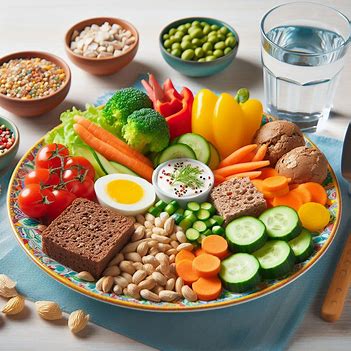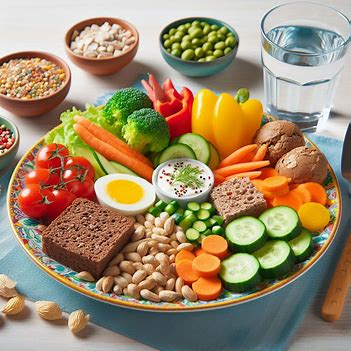Special Diets
Yeast-Free Diet

Yeast-Free Diet is designed to eliminate foods that contain or encourage the growth of yeast and other fungi in the body. This diet is often recommended for individuals with yeast overgrowth, such as Candida infections, or those with yeast sensitivities or allergies. The goal is to reduce the amount of yeast in the digestive tract, which can help balance gut bacteria and improve overall health.
Why Follow a Yeast-Free Diet?
- Candida Overgrowth: Candida is a type of yeast that normally lives in the gut, but it can grow excessively, leading to various health problems like bloating, fatigue, and infections.
- Yeast Sensitivity: Some individuals experience digestive issues, headaches, or skin problems when they consume foods containing yeast.
- Chronic Conditions: People with conditions such as chronic fatigue syndrome, irritable bowel syndrome (IBS), or weakened immune systems may follow this diet to manage symptoms.
Foods to Avoid on a Yeast-Free Diet:
The focus is on avoiding foods that contain yeast or that promote yeast growth in the body.
1. Yeast-Containing Foods:
- Baked Goods: Bread, bagels, pastries, and anything made with baker’s yeast.
- Alcohol: Beer, wine, and any alcohol made through fermentation.
- Fermented Foods: Vinegar, soy sauce, miso, sauerkraut, kimchi, and pickles (as these may contain yeasts or encourage yeast growth).
- Certain Processed Foods: Pre-packaged foods that may contain yeast or yeast extract as a flavor enhancer (often found in soups, sauces, and snacks).
2. Sugary Foods:
- Refined Sugars: Candies, sodas, desserts, and anything with high fructose corn syrup.
- Natural Sugars: Some versions of the diet restrict fruit or fruit juices, as sugar can feed yeast growth in the gut.
- Processed Carbohydrates: White bread, white rice, and pasta, which can quickly convert to sugar and promote yeast growth.
3. Moldy or Fungus-Containing Foods:
- Mushrooms: While mushrooms are technically fungi, not all yeast-free diets require their elimination. However, some strict versions may recommend avoiding them.
- Certain Cheeses: Blue cheese, brie, and other mold-containing cheeses.
Foods You Can Eat on a Yeast-Free Diet:
The diet emphasizes fresh, whole foods that don’t contain yeast or sugars that feed yeast growth.
1. Fresh Vegetables:
- Non-starchy vegetables like leafy greens, broccoli, cauliflower, peppers, and zucchini.
- Avoid: Starchy vegetables like potatoes and corn in some stricter versions of the diet.
2. Lean Proteins:
- Chicken, turkey, fish, and eggs.
- Plant-based proteins like lentils, chickpeas, and tofu (though some processed versions of soy may be discouraged).
3. Whole Grains:
- Quinoa, brown rice, millet, and buckwheat (as long as they are not fermented).
- Yeast-free gluten-free bread and crackers are allowed in some variations of the diet.
4. Nuts and Seeds:
- Almonds, walnuts, chia seeds, and flaxseeds (avoiding mold-contaminated nuts if necessary).
5. Healthy Fats:
- Olive oil, coconut oil, and avocados.
6. Low-Sugar Fruits (in moderation):
- Berries (blueberries, raspberries), avocados, lemons, and limes are usually allowed.
Health Benefits of a Yeast-Free Diet:
- Improved Gut Health: By reducing yeast overgrowth, this diet may help balance the gut microbiome, reducing symptoms of bloating, gas, and indigestion.
- Increased Energy: Many who follow a yeast-free diet report improvements in energy levels, particularly if they have been suffering from Candida overgrowth or food sensitivities.
- Clearer Skin: Some people experience improvements in skin conditions like acne or eczema.
- Reduced Inflammation: Cutting out processed foods and sugars that can cause inflammation may improve symptoms of chronic conditions.
- Better Immune Function: A healthy gut can contribute to a stronger immune system, reducing infections and illness.
Potential Drawbacks:
- Restrictive: The diet can be difficult to follow, especially since it eliminates common foods like bread, alcohol, and sugar.
- Risk of Nutritional Deficiencies: Cutting out whole food groups like fruits or fermented foods may lead to deficiencies in certain nutrients, especially fiber or probiotics.
- Social and Practical Challenges: Avoiding yeast-containing foods can be challenging when dining out or traveling.
Who Should Consider a Yeast-Free Diet?
- Individuals with recurrent yeast infections, especially Candida.
- People experiencing chronic digestive issues like bloating, gas, or IBS that may be related to yeast overgrowth.
- Those with yeast allergies or sensitivities.
Conclusion:
A yeast-free diet can be beneficial for individuals dealing with yeast overgrowth, digestive issues, or sensitivities to yeast. However, it is quite restrictive and may not be necessary for everyone. If you’re considering this diet, consulting with a healthcare provider or nutritionist is recommended to ensure it’s appropriate for your health needs.
